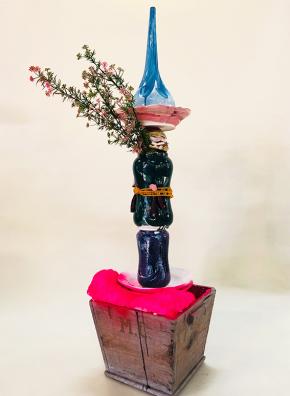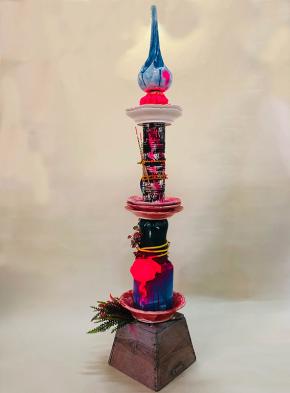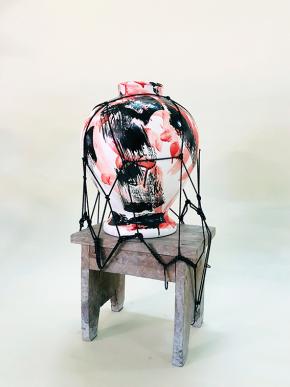(RE)MEMBERING / (FOR)GETTING by Rita GT
“(Re)membering/(For)getting: The troubled ceramic histories of Portugal at home and abroad.”
An invitation to ‘(re)member/(for)get’, is an invitation to remember and forget something as well as to simultaneously break and ‘member’ and ‘get’ it again differently. It is a fugitive attempt to reimagine our histories differently.
 your strong tongue and slender fingers, totem series, 2019, porcelana, vidrado colorido, spray, madeira, plástico, corda, espuma
your strong tongue and slender fingers, totem series, 2019, porcelana, vidrado colorido, spray, madeira, plástico, corda, espuma  your strong tongue and slender fingers, totem series, 2019, porcelana, vidrado colorido, spray, madeira, plástico, corda, espuma
your strong tongue and slender fingers, totem series, 2019, porcelana, vidrado colorido, spray, madeira, plástico, corda, espuma
At the heart of all imperial powers, Portugal included, has been an incredible ability to forget, an incredible factory to forget. The task for artists, writers and thinkers is to analyse this process of re-membering and forgetting. Artists and thinkers who are situated as outsiders because of their work on identities and otherness offer us a decolonial and dewestern option that allows us to confront those histories of modernity that grew out of the 15th century, histories that were shaped by 1492 which are so often described as being about the discovery and exploration, that is euphemistically called the encounter – catastrophe for indigenous people and a crisis in European thinking. The challenge facing us now is an invitation to (re)member with the construction of differentness to help to form a line of thinking about the interstice which by rearticulating the memory of our past and present his- tory, origins and displacements, we are able to forge a process of a new process of (re)membering.
Ceramics is a symbol of Portuguese history. Its place in the ‘domestic’ puts its centre stage in the ideological production and circulation of gender and feminist work. In Southern Africa, the place that I think from, the Portuguese had been present in the region for 400 years beginning with Vasco Da Gama’s ‘explorations and discoveries’ and before the British arrived just over a hundred years ago. Vasco da Gama and others took with them Portuguese tiles, ceramics and ornaments on these so-called voyages of discovery and exploration. A great deal has been written about what these colonialists and settlers got up on arrival in Africa, in Brazil and in the many islands scattered on the Indian ocean, but very little has been written or said about the lives of the women who accompanied these ‘explorers’ or those women who set out to settle in the colonies. The argument here is that reading ceramics as the symbol of Portuguese history enables us to bring into visibility the experiences of these women when they arrived on the shores of Africa and Brazil, and also to (re) member how gender and sexualities were reconfigured.
 Delicate your lovemaking, 2019, porcelana, corante, spray, madeira, cordaI was born in rural Zimbabwe, at Mashinge Village approximately 35 miles north of Harare. In my grandmother’s kitchen were some beautiful stacked clay pots. The traditional kitchen represented the artwork of elaborate shelves made of polished clay. The kitchen was the hut and centre of everything that happened in the homestead. Children were born there, the food was cooked there, and ceremonies were held there. When people died the body of the dead was kept overnight in the hut that makes the kitchen. My grandmother said that the kitchen was were we started and where we were all expected to spend our last night on earth. The decoration of the kitchens was made colourful and beautiful the use of clay pots nicely polished and oiled with peanut butter oil. Women were the pottery makers and the decorators of kitchens and other household rooms.
Delicate your lovemaking, 2019, porcelana, corante, spray, madeira, cordaI was born in rural Zimbabwe, at Mashinge Village approximately 35 miles north of Harare. In my grandmother’s kitchen were some beautiful stacked clay pots. The traditional kitchen represented the artwork of elaborate shelves made of polished clay. The kitchen was the hut and centre of everything that happened in the homestead. Children were born there, the food was cooked there, and ceremonies were held there. When people died the body of the dead was kept overnight in the hut that makes the kitchen. My grandmother said that the kitchen was were we started and where we were all expected to spend our last night on earth. The decoration of the kitchens was made colourful and beautiful the use of clay pots nicely polished and oiled with peanut butter oil. Women were the pottery makers and the decorators of kitchens and other household rooms.
The Portuguese and other imperial powers brought with them hordes of Christian missionaries. These missionaries led the campaign that saw clay pots taken from these kitchens smashed to pieces because they provided a historic link with our ancestors and were considered sinful. When the women who accompanied the explorers arrived on the shores of Africa, Brazil and elsewhere, their pottery had been broken by the sea and the ceramics smashed to pieces. In both cases it was the breaking of ceramics.
__________
The exhibition “(Re)membering / (For)getting” by Rita GT, Galeria Belo-Galsterer, Lisbon, until 30th March 2019.